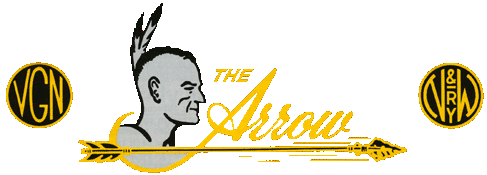| Cover Story: The Many Stations of Mullens / A Virginian History Special - Martin E. Swartz |
| |
Photo |
This hand-tinted postcard, a process commonly used in the old days to display railroad images, shows the Mullens station at the peak of its glory, in pumpkin orange with white trim. (Lloyd Lewis collection, copy courtesy Jack Feller) |
| |
Drawing |
These plans are similar to the first Mullens station, the main difference being that the station had no race-separate waiting rooms. (Martin E. Swartz Collection) |
| |
Photo |
In this pre-1917 view of the original Mullens station, a relaxing bovine joins the other passengers in awaiting the afternoon accommodation. (Robert R. Keller Collection, WV State Archives, Courtesy Thomas R. Marshall, Jr) |
| |
Photo |
This photo shows the rear of the Mullens station during the reconstruction of Mullens after a large fire on 8/12/1919. Compare this to the backside layout of the 22 foot by 80 foot station in the bottom drawing on the opposite page. Note that a corner of the freight extension is peeking around the far side of the tall structure blocking our view, but the platform canpoies have not yet been added. (Jack Feller Collection) |
| |
Drawing |
This standard station plan is basically a lengthened variation of the 22' x 60' design, having a double window in the waiting room, a triple window in the operator's bay, and two additional transom-type windows in the freight room. (Martin E. Swartz Collection) |
| |
Photo |
Workmen do some trackwork at the Mullens station around 1955. This view, and the one taken a couple of years later below, shows how the station was built to accommodate the track curve. (Columbia Gas Collection, WV State Archives, Courtesy Thomas R. Marshall, Jr.) |
| |
Photo |
Upon the cessation of passenger service in 1956, the once-lengthy station got the axe also, getting truncated by almost half. The new tailfinned Plymouth is admired by Lee Harmon, J.S. Graveley, and Pete Andrews (Steve Summers Collection) |
| |
Sidebar |
Virginia Stations: What was planned, what was built, with "Virginian Station Data from Annual Reports". List of station data (milepost, town, state, type, size, and AR citation) |
| |
Photo |
16'x40' Combination, with Whitehorne, VA photo, and "Tidewater-Deepwater Railway: Standard 40 x 60 station" drawing (Martin E. Swartz Collection) |
| |
Photo |
22'x60' Combination, with Mullens, WV photo, and "Tidewater-Deepwater Railway: Standard 60 x 22 station" drawing (Martin E. Swartz Collection) |
| |
Photo |
24'x60' and 26'x70' Combination, with Long Island Va & Rich Creek, VA photo, with drawing (Martin E. Swartz Collection) |
| |
Photo |
22'x90' Combination, with Pembroke, VA & Salem, VA photo, This pattern was used at Eggleston, Lester, Pembroke, and Salem. (Martin E. Swartz Collection) |
| |
Drawing |
Passenger Shelter: This is the arrangement drawing of the standard Shelter-Type Station. The 1937 Annual Report indicates that these were placed at many locations when staffed stations were retired, although they were probably used previously in other locales of modest population. |
| History & Modeling of the Abingdon Branch / From rails to trails - Clinton Smoke |
| |
Photo |
In a rarely seen 1925 photo, the Virginia Creeper is traveling across one of the many bridges on the Abingdon Branch. In these early days, the train was passenger-only, and the consist was made up of open-vestibule coaches. A few years later, it would be downgrade to mixed status, and passengers would have to bide their time while the freight cars were switched along the line. (VPI&SU Collection) |
| |
Photo |
The bridge over Holtson River, once traversed by a Class M and a rag tag mix of cars, is now reserved for those who wish to enjoy Southwestern Virginia nature in all its glory, either on foot or by a leisurely bike ride. (Clinton Smoke Photo) |
| |
Photo |
Then and Now: The tracks are long gone, but the trail remains. Those attending our convention will have the opportunity to rent bicycles and enjoy the Creeper Trail for themselves. (Clinton Smoke, Jr. Photo) |
| |
Photo |
A Class K hurries past the Abingdon passenger station in the early 50s with a time freight. (VPI&SU Collection) |
| |
Photo |
Today, the station still exists in fine shape, (sans passenger shed) housing the town police department. (Clinton Smoke, Jr. Photo) |
| The Tennessean / Modeler's wish list possibilities, and the Unicorn found - James Nichols |
| |
Photo |
Al Gerard's Class A demonstrates his scratch building talents. (Al Gerard Photo) |
| |
Photo |
The elusive "Unicorn" photo... found at last! (Thomas D. Dressler Collection) |
| Virginian Local / The new VGN models - Martin E. Swartz |
| View from the Cab / High Wide Trains - Thomas D. Dressler |
| 1997's Roster of Sustaining Members / We acknowledge those that go the extra mile - Unknown Unknown |
| Tales from the Front / "I grew up on the Dry Fork Branch" - James B. Scott |
| |
Photo |
Mining coal at the Bruiquette Plant and tipple in Berwind, WV. This photo is from the mid-1930's. (VPI&SU Collection) |
| Current News / What's happening in today's railroading - Robert G. Bowers |
| |
Photo |
An N&W C30-7 #8010, in resplendent Tuscan red, takes charge of a Norfolk and Western business train in August of 1979. Sadly, the paint scheme was short-lived, and this unit, as well as 4 of her sisters, were repainted black (inset, 1982) a short time later. (Bob Bowers Collection) |

